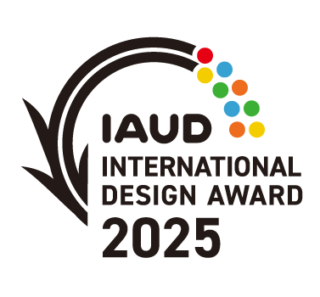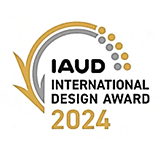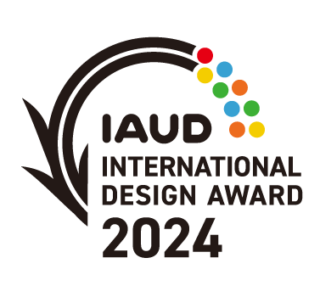IAUD Awards Citations 2016 CHAIRS INTRODUCTION & FULL CITATIONS
2016.12.09 Updated
CHAIRMAN’S INTRODUCTION
The Chair of IAUD Award 2016 Selection Committee
Professor Emeritus, Royal College of Art, UK

(Konnichiwa. Good day everyone and welcome to the 2016 IAUD Awards Ceremony.)
Each year, as Chair of the Awards Selection Committee I am impressed and encouraged by the ingenuity, concern and attention to detail shown by the entries, and the progress they represent towards the goal of creating a universally accessible and enjoyable ‘society for all’.
Through the Major Awards – at Grand, Gold and Silver level – the judges are seeking to promote and commend high-quality examples of Universal Design practice, methodology and delivery, and of company-wide commitment to Universal Design as a driver for continuous improvement in product and service delivery. IAUD Awards are given to all entries that meet or genuinely strive to meet Universal Design standards of user-engagement in the design process, user-friendliness, sustainability, inclusion, dialogue and knowledge transfer, and in the few cases where these standards are not met no award is given.
Last year I, and my fellow jurors, commented on the widespread and growing understanding of Universal Design in practice demonstrated by the entries. This year we saw an emphasis on improvement rather than simple innovation, and how an understanding of the fundamentals of Universal Design was leading the realization that through continuous improvement, products and services can meet the needs and aspirations people in general as well as those with special needs.
By becoming more inclusive in their goals, this year’s entries prove to us that with attention to personal preferences and lifestyle – the soft side of user-friendliness – Universal Design is increasingly recognized as simply ‘good’ design and pointing the way to a considerate ‘society for all’ as the norm, rather than an aspiration.
That was the primary goal of the late and beloved Prince Tomohito, when IAUD was founded some 15 years ago, and to see that becoming real is a great pleasure to all of us who have since worked towards that end. Once again, Her Imperial Highness Princess Yoko, the second daughter of Prince Tomohito and Patron of IAUD, joined the final jury session and shared the process of selection and the discussions around each entry. The jury greatly welcomed her close interest and contribution to the deliberations, and we look forward to her future support and valued input to the awards.Announcement of IAUD Awards 2016 Winners
SELECTION CRITERIA
The main selection criteria are “whether the principles of universal design (UD) have been espoused and whether superior activities to achieve them have been proposed or carried out.” Judging is based on both the advocacy of the principles and the activities and actions that result from it. Both are comprehensively evaluated as a whole. The judging perspective mentioned in the application requirements is also given importance in the evaluation process.
- Sustainable and Universal: The entry presents concepts and practices suitable for creating a sustainable, mutualistic society.
- Diversity and Inclusion: The entry shows an understanding of the diversity of traditions, cultures, lifestyles and people, and does not exclude minorities but rather expressly includes them; and thus contributes to realizing a qualitatively rich and happy way of life.
- Safe and Secure Society: The entry contributes to the construction of mechanisms, systems and morals appropriate to a society that protects human rights and respects the humanity of every individual.
- Spontaneous and Sustainable Dialogue: The entry serves to build ongoing exchanges and relationships between corporations, government, research institutions, NPOs, and citizens.
- Passing-on of Knowledge and Skills to the Next Generation: Through disseminating universal design and knowledge about it, the entry serves to cultivate individuals suited to lead the next generation.
IAUD Award 2016 Selection Committee
- The Chair of the Selection Committee: Roger Coleman (Professor Emeritus of the Royal College of Art, UK)
- Vice Chair of the Selection Committee: Fumikazu Masuda (President, open house inc., Japan)
- The member of the Selection Committee:
- Francesc Aragall (President, Design for All Foundation, Spain)
- Thomas Bade (CEO, Institute for Universal Design, Germany)
- Valerie Fletcher (Executive Director, Institute for Human-Centered Design, USA)
- Toshiharu Arai (Professor Emeritus, Kanazawa College of Art, Japan)
- Keiji Kawahara (Professor, Head of Department of Design, School of Media and Design / Graduate School in Media and Design, Nagoya University of Arts and Sciences; Executive Director, IAUD, Japan)
GRAND AWARDS (2 Joint Grand Awards)
- In the category of Communication Design
- Fujitsu Ltd. receives a Joint Grand Award for:
FUJITSU GUI Next Plus
-New GUI design platform for developing software that more people will feel comfortable- – a new graphic user interface.
http://www.fujitsu.com/jp/group/fdl/en/index.html
Across-platform consistency of information presentation is a crucial and much neglected issue, as is consistency in interface design. With the rapid evolution of operating systems and business and personal software, frequent interface design changes can frustrate and inconvenience the user. Cross-platform issues can make this worse, where the same information is presented on desktop screens, laptops, tablets and mobile devices, often in different formats and with different modes of interaction. In tackling this issue at a fundamental level, by standardizing basic elements, presentation and interaction across devices and between software programs, Fujitsu is showing a way forward that prioritizes consistency within the spirit of UD and follows the Web Accessibility Initiative’s Web Content Accessibility AA guidelines. Although essentially visual, this new graphic user-interface design is an important and essential step on a path to full consistency and accessibility, introducing a new standard in business management software.
The jury welcomed the consideration given to user issues and how these were being addressed at a system level as a template for all Fujitsu software Fujitsu. It sees this as the much-needed beginning to the prioritization of consistency and accessibility, from a user perspective in the evolution of software and interface design.
- In the category of Public Space Design
-
The Danish Muscular Dystrophy Foundation/ Musholm Holiday – Sport – Conference (Musholm Resort) receives a Joint Grand Award for:
With its multi-purpose hall and 24 new rooms, the Danish “Musholm Holiday–Sport– Conference” (Resort) sets a new standard for diversity
The Musholm Holiday, Sport, and Conference Centre
With its multi-purpose hall and 24 new rooms, the Musholm Holiday, Sport, and Conference Centre sets a new standard in recreational provision for diversity. Through an exemplary participatory design process the Danish Muscular Dystrophy Foundation has combined responsiveness to the environment with making the most of the human experience. With a rich palette of materials, finishes and colors, the Musholm Centre combines high functionality in a recreational setting with outdoor and private space around water to deliver a rich and relaxed experience for MD suffers to share with family, friends and the general public.
While conscious that the central purpose was to develop a recreational centre for the community it serves, the Jury commended the Danish Muscular Dystrophy Foundation for approaching this in a truly inclusive spirit and through a participatory design process delivering a resort and conference centre for all.
GOLD AWARDS (7)
- In the category of Communication Design
- Panasonic Corporation receives a Gold Award for:
Accessibility improvement efforts toward Tokyo Olympic and Paralympic Games
Large numbers of foreign visitors are expected to visit Japan during the Olympic and Paralympic Games, and while Japan prides itself on its transport systems and the levels of UD already achieved, there is still much to do if this influx of visitors is to feel welcome and find the capital accessible. By applying UD thinking in an holistic way and working closely with critical user groups, Panasonic Corporation is developing and trialling an integrated suite of hardware and software solutions to facilitate mobility and navigation, in particular for overseas visitors in transit.
The jury thought that the Panasonic approach to this challenge had delivered a practical, and well-integrated mix of hardware and software solutions.
- In the category of Public Space Design
- The Canadian Museum for Human Rights receives a Gold Award for:
The Inclusive Museum
The objective of the museum’s activities is to create an inclusively rich experience for all, irrespective of individual ability. To this end an 11-strong Inclusive Design Advisory Committee and an internal working group have been established and a rigorous iterative design process has been put in place. This approach spans all areas of the museum’s activities and touches on architecture, facilities, exhibitions, education, planning and digital media and technology, and has led to detailed inclusive design and accessibility standards.
The jury applauded the emphasis on shared methodology as a great example of “baked-in” UD and a good model of inclusive and on-going practice, research and dissemination. In particular, the resulting user interface design of video guidance in the museum is simple and intuitive for all including deaf people.
- In the category of Public Space Design
- NATIONAL CHARITY FOND “BARRIER FREE CITY” Parent organization: The Baltic Architecture Center receives a Gold Award for:
Concept of The barrier-free environment in the historic center of Kuldiga, Latvia
Delivering real accessibility is a challenging problem for historic sites and city centers, and very pronounced in the European context. This Latvian initiative is based on thorough research into best practice and a program of knowledge-transfer and education to build the required competence locally. This is an excellent and well-founded beginning which is likely to deliver long-term results.
The jury found this a rare initiative originating in a school of architecture and resulting in an impressive cross-disciplinary collaborative effort with citizens, which will go a long way to plugging the UD knowledge-gap in an area where there is only limited local experience and capability.
- In the category of Co-Design
- Fujitsu Ltd. receives a Gold Award for:
The spiral of diversity that links community, company and employee, and empowers people
An excellent example of a company-wide initiative building on the mutual benefits of engaging with and understanding diversity. A program of shared-experience workshops and recreational events brings Fujitsu employees together with a very diverse range of people from local and regional communities. The result is an empathic engagement with difference and diversity that nurtures resilience among employees and feeds back into company culture and R&D. A virtuous circle that benefits all involved.
The jury welcomed the focus on diversity and innovation driven by a range of awareness-raising activities within an overall initiative to integrate UD in corporate culture, citing it as a good example of diversity and inclusion.
- In the category of Co-Design
- Baba–Lab / Shigoto Lab / Shibaura Institute of Technology receive a Gold Award for:
Baby Bottles Exclusively for Raising Grandchildren: Ho Ho Ho Honyubin
An exemplary co-design process leading to a series of user-friendly ergonomic improvements to baby-bottle design with grandparenting in mind. A delightful idea that has come directly from user experience and meets a very real need. Grandparents play an increasingly crucial role in looking after young children and babies, especially when families are shrinking and both parents often work. It also helps to cement inter-generational relationships, which are and will be crucial in Japan and all societies subject to population ageing.
The jury commended the unique perspective behind this initiative in the creation of new multi-generational workplaces, along with this elegantly designed user-friendly baby bottle suitable for grandparents and others caring for babies.
- In the category of Service Design
- Yamaha Corporation receives a Gold Award for:
Sound Universal Design System “Omotenashi Guide”
The Omotenashi Guide is a smartphone-based system enabling the text display, with appropriate translation, of emergency, and public announcements for tourists and other foreign-language speakers. No WifF is required making it simple to install and robust in operation in conjunction with existing broadcast equipment. Already in use in many settings, and with well-established partnerships for delivery, this service design offers immediate and welcome benefits to foreign language speakers.
The jury commended the simplicity and practicality of the Omotenashi Guide, particularly in the context of the 2020 Olympic and Paralympic Games, when Japan will be host to large numbers of overseas visitors.
- In the category of Sports Design
- YMCA Victoria in partnership with the Department of Health and Human Services (Victoria) receives a Gold Award for:
Universally Designed High Challenge Ropes Course
As funding and sponsorship criteria push inclusion and UD, this is an excellent example of how to think inclusively in facility design, and in particular where sports are involved. Although UD equipment for extreme and challenging sports has been in existence for some years, Camp Manyung’s outdoor adventure activity programs constitute an exemplary implementation of an extreme sporting experience in an inclusive environment, where everyone attending regardless of age, capability or background is able to share the same adventurous experience, without barriers or segregation.
The jury was impressed with this excellent implementation of accessibility in an extreme environment where everybody faces the same challenges, delivering fun and positive life quality for all. And in particular its dramatic impact over two years including increased revenue.
SILVER AWARDS (12)
- In the category of Long-term Achievement in Universal Design
- Fujitsu Ltd., Fujitsu Connected Technologies Ltd., and Fujitsu Design Ltd. receive a Silver Award fors:
Raku Raku Smartphone
An excellent example of continuous product improvement, building on past experience and customer feedback. With plenty of user-consultation, Fujitsu’s Raku Raku smartphone demonstrates how to achieve and maintain product improvement through inclusive design / UD. The Raku Raku smartphone can be used by senior citizens and people with visual disabilities. It has inherited the basic user-friendliness earlier iterations, and with its easily viewable and usable touch panel and interface offers a full range of support functions to connect with family and friends.
The jury applauded Fujitsu for its15-year history of application and development towards UD and the Raku Raku smartphone as a long lasting example of good UD in Japanese phone design.
- In the category of Communication Design
- Panasonic Corporation receives a Silver Award for:
Automatic multilingual audio translation system
This system for facilitating smooth communication and conversation with foreign visitors to Japan combines a high-accuracy translation engine and noise reduction audio technology to offer a reliable service for handling translation between Japanese and multiple languages. Hands-free conversation is possible, while intuitive operation and simultaneous translation displays enable stress-free conversation.
The jury found this a potentially exciting initiative in the early stages of development and in need of further attention to real-life use situations. There is scope to develop the interface and underlying service concept in preparation for the 2020 Olympic and Paralympic Games.
- In the category of Communication Design
- Mitsubishi Electric Corporation receives a Silver Award for:
Voice-activated Drawing Function that Displays Spoken Words Where Finger is Traced on Screen
This communication application was developed for tablets and smart phones. It incorporates a range of functions, including drawing and multi-language translation, and uses speech recognition and display technology to show words that are spoken in a trail behind where a finger is traced. The intention is to facilitate smooth communication with the hearing impaired and people from overseas, in particular for people unable to use sign language or speak a foreign language. The combination of voice activation, drawing and translation capabilities make it ideal for visual communication across languages.
The jury commended this entry for promoting natural communication and interaction, but felt there was scope for further development through user testing and feedback.
- In the category of Communication Design
- Fontworks Inc. receives a Silver Award for:
Pursuance of Beautiful and Easy-to-Read Fonts –
A well-designed and significant collaborative research program with the University of Kyushu. Easy to read, and well-formed font design – readability and aesthetics combined – is essential to delivering UD across digital platforms. Direct testing with users formed the basis of this on-going R&D project, with 60 fonts tested against a range of criteria, including readability, visibility and discernibility, and importantly, aesthetics. The result is a better understanding of UD for font design.
The jury considered this critically important work in a digital world, especially as the predominant focus to date has been on Western languages and letter forms.
- In the category of Public Space Design
- Toshiba Corporation / Toshiba Elevator and Building Systems Corporation receive a Silver Award for:
Station elevator
Toshiba has developed a new station elevator in cooperation with the Universal Design Laboratory at Keio University. This 15-person elevator can accommodate two wheel chairs at the same time—the first elevator in the industry capable of doing so—while operating panels in the front and back mean that two wheelchair users can operate the elevator easily. Repeated user testing and evaluation validated the location and functions of the operating before launching the product.
The jury praised this user-based, iterative design collaboration with Keio University, for ensuring high levels of usability and functionality.
- In the category of Public Space Design
- Quadrangle Architects Ltd., Toronto, receives a Silver Award for:
100 Broadview Lobby
This lobby renovation created a universally accessible entrance to a commercial building with a zigzagging ramp that puts accessibility centre-stage and gives identity and character to the building. Colorful and icon-based wayfinding elements in combination with the feature ramp and high-contrast pathways support those with low vision and create a path for users of mobility devices. The result is a good piece of intentional, in-your-face universal design: provocative but successful in creating a multi-use environment with an arresting frontage.
The jury commended this as an excellent example of environmental and social sustainability, delivering inclusion within an existing structure, and a good illustration of the mingling of function and aesthetics.
- In the category of public Space Design
- Parques de Sintra – Monte da Lua S.A receives a Silver Award for:
Parks of Sintra Welcome Better
Cultural heritage sites are a big challenge to UD, but increasingly important in the European context of social inclusion and globally, with the growing importance of tourism and international travel. Achieving accessibility without compromising historic detail is not easy, and this project is an excellent example of good practice focused as much on ‘soft’ factors – staffing and information – as the hard features and equipment normally associated with accessibility, The success of this approach is borne out by the growth in visitor numbers and satisfaction levels.
The jury applauded this entry as a fine example of retrofitting for accessibility in a UNESCO historic site, featuring the renovation of grounds and buildings to deliver accessibility in a challenging environment.
- In the category of Housing Equipment Design
- Panasonic Corporation receives a Silver Award for:
Home elevator 1608 Joymodern S200V
With its compact space-saving and economical construction, this easy-to-install home elevator allows people to age in place. Developed in collaboration with Keio University it is affordable to people who might previously have been unable to consider a home elevator. Emergency procedures and reporting are easy, and safety in getting in and out of the elevator is ensured, while controls including voice announcement and voice command buttons are easy to use and can operated with confidence.
The jury commended an excellent user-based study, an iterative design process and a good understanding of how a domestic elevator can be installed in a limited space.
- In the category of Healthcare & Welfare Design
- Mitsubishi Electric Corporation receives a Silver Award for:
Particle beam therapy treatment rooms that can be safely and comfortably used by both patients and operators
Particle beam therapy, like body scanning can be very intimidating. How patients feel in the treatment environment – the soft side of medical equipment and facility design – has a big impact on how well they respond to treatment. In this case, serious attention has been given to ‘humanizing’ the hospital experience through careful attention to lighting, color, materials and space design.
The jury welcomed this entry as an excellent example of holistic solutions for a complex situation, pertinent to anyone across the spectrum of ability and age, and equally supportive of hospital staff.
- In the category of Healthcare & Welfare Design
- Panasonic Hearing Instruments Co., Ltd. receives a Silver Award for:
G3 Series, Rechargeable In-The-Ear Hearing Aid
This hearing aid benefits from a suite of innovative design improvements that eliminate changing tiny batteries and move controls to a user-friendly remote control. Handling, cleaning and maintenance are simplified and beeps and whistling controlled automatically. Coupled with improved processing these features ensure a good user experience.
The jury commended this entry for its user-focused approach, and hope this leads to much-needed revolution in hearing aid technology and design bringing them closer into line with quality consumer audio equipment.
- In the category of Healthcare & Welfare Design
- Glowing Co. Ltd. receives a Silver Award for:
Organic Cotton Wig – Witton
Hair loss through disease or medical treatment is a traumatic experience for many people, and there are medical and psychological problems associated with the materials and appearance of ‘medical’ wigs, for which there are no common standards. This product sets out to remedy this situation by combining natural materials with attention to detail and appearance, and was developed on the basis of user-research.
The jury welcomed the use of organic materials and attention to the role of aesthetics in disease management. It also praised the associated awareness-raising program whereby donated human hair is used to make wigs that are donated children with hair loss.
- In the category of Agriculture
- Fujitsu Ltd. receives a Silver Award for:
Agricultural Production Management Cloud for a Revitalization of Japanese Agriculture
A significant challenge facing Japanese agriculture is a shortage of people to carry on the industry coupled with a failure to effectively transfer skills and techniques across generations. Fujitsu has addressed this problem with a dedicated cloud-based service designed to capture and pass on knowledge and experience and also to better manage and time agricultural processes and operations.
The jury commended Fujitsu for building on its cross-platform graphic interface to deliver a user-friendly service driven by highly practical software based on demonstration experiments and user-consultation.









